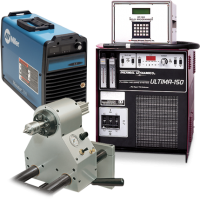 YAG: Laser Welding
YAG: Laser Welding
An acronym for yttrium- aluminum-garnet, the YAG laser produces short-pulsed, high- energy light beams to weld metals. This laser may also be called a neodymium-YAG or ND -YAG laser. A laser type using an infra red wavelength of 1064 nanometers. The laser material is neodymium. The beam provides a concentrated heat source, allowing for narrow, deep welds and high welding rates.
Laser beam welding has high power density resulting in small heat- affected zones and high heating and cool- ing rates. The spot size of the laser can vary between 0.2 mm and 13 mm, though only smaller sizes are used for welding. The depth of penetration is proportional to the amount of power supplied, but is also dependent on the location of the focal point: penetration is maximized when the
focal point is slightly below the surface of the workpiece. A continuous or pulsed laser beam may be used de- pending upon the application. Milliseconds long pulses are used to weld thin materials such as razor blades while continuous laser systems are employed for deep welds. LBW is a versatile process, capable of welding carbon steels, HSLA steels, stainless steel, aluminum, and titanium.
Micro-Plasma Welding Process
Plasma arc welding (PAW) is an arc weld- ing process similar to gas tungsten arc weld- ing (GTAW). The electric arc is formed be- tween an electrode (which is usually but not always made of sintered tungsten) and the
work piece. The key difference from GTAW is that in PAW, by position- ing the electrode within the body of the torch, the plasma arc can be sepa- rated from the shielding gas envelope. The plasma is then forced through a fine-bore cop-
per nozzle which constricts the arc and the plasma exits at the orifice at high velocities (approaching the speed of sound) and a temperature approaching 20,000 °C. Plasma arc welding is an advancement over GTAW.
The Advantages of Laser Welding
- Precise Energy Input
- Minimum Heat Effected Zone
- The Weld is Cool to Touch Seconds After Welding
- Welds Can be Sited in Close Proximity toSensitive Components or Structures
- Non-Contact Welding
- Precise Control of Laser Beam Pulsing Profile
- No Contamination From Tungsten Particles
- No Heat Discoloration
- Welds Magnetic Materials
- Low Heat Distortion
- No Need for Elaborate Heat Sinks
- High Travel Speeds
- Highly Reproducible Welds
- Advantages of Laser Welding in Tool & Die Repairs
____________________________________________________________________
The Advantages of Plasma Welding
- Thin Wire Deposition Using Microscope for Positioning
- Ability to Weld in Deep Holes and Cavities
- Protected electrode, offers long times before electrode maintenance (usually one 8 Hr Shift)
- Low amperage welding capability (as low as 0.05 amp)
- Arc consistency and gentle arc starting produce consistent welds, time after time
- Stable arc starting and low amperage weld- ing
- Minimal high frequency noise issues, HF only in pilot arc start, Pilot Arc Used to Transfer Main Arc
- Arc energy density reaches 3 times that of GTAW. Higher weld speeds possible
- Weld times as short as 10 msecs (.01 secs
- Energy density reduces heat affected zone, improves weld quality
- Voltage of Arc Remains Constant WhenLength of arc Changes
- Diameter of arc chosen via nozzle orifice
- Lower Cost Than Laser
The Cost Differences Between Laser and
For laser Welding Systems the Prices Vary According to the Power Needed. For Thin Materials Usually Low Power YAG Lasers are Sufficient. Low Power YAG Lasers Range in Size from 55 Watts to Several Hundred Watts. Class 1 Lasers come with a Safety Enclosure Around Them. Class Four Lasers are Open. YAG Low Power Lasers Range in Price from $35K to $110K. Higher Wattage Lasers in the Kilo Watt Range Can Cost Several Hundred Thousand Dollars.
Micro-Plasma Welding Systems are Categorized by Welding Current Output. Most Micro-Plasma Welders On the Market have Outputs Be- tween 0.5 to 150 amps. Micro-Plasma Applications use a Welding Current Between 0.5 to 30 amps. In some Cases However Higher Welding Current is Needed. Depending on What is Needed for the Application the Prices of Micro-Plasma Welding Systems can Vary Be- tween $10K for a Manual System, to $17K for a Programmable System.
Special points of interest:
- Short Definition of YAG: Laser and Plasma
- Process Advantages
- Cost Differences
